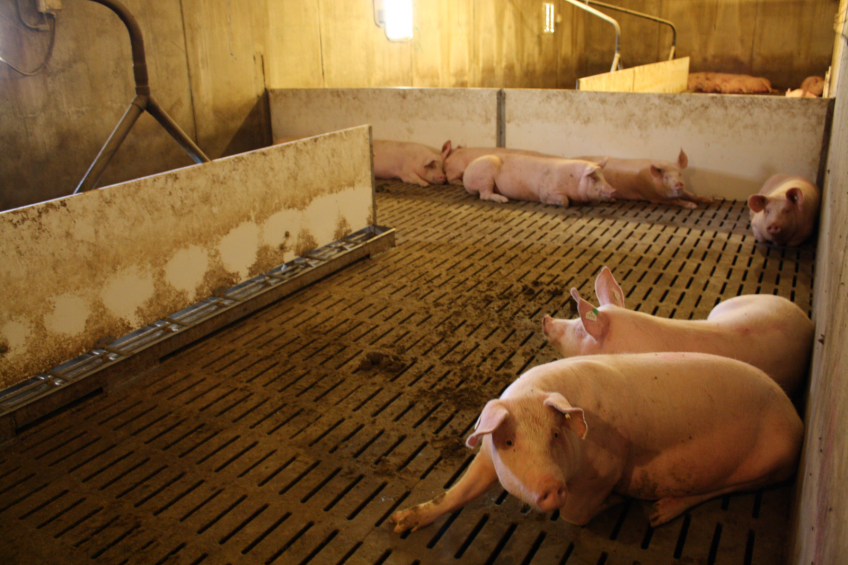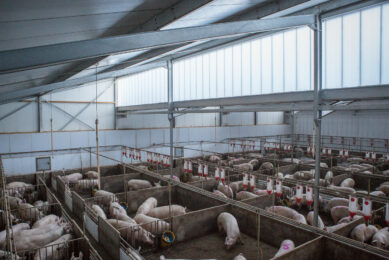Sow housing: Good welfare depends on good stockmanship

Group housing or not? The issue is growing in importance in North America as resistance accumulates against conventional sow stalls. Canada’s Prairie Swine Centre dived into the issue and collected recent pros and cons. Their conclusion: Regardless of housing system, sow welfare depends primarily on good stockmanship.
Several scientific studies and reviews have compared the welfare benefits of stall versus group housing for gestating sows. The conclusions of these studies vary because welfare assessment involves a variety of measures, and the conclusions reached will vary depending on the emphasis placed on different measures. The key measures and results of studies comparing sow welfare in stalls and groups are summarised below under the headings: Sow health and performance, stress physiology, sow behaviour, and sow aggression. Evaluation of the welfare of sows must consider all and not just some of these factors, and the results show that there are advantages and disadvantages to both stall and group housing systems.
Welfare assessment
A comprehensive approach to animal welfare assessment has been described by David Fraser with three approaches, examining measures related to:
1. Health and productivity (biological function);
2. Subjective experiences (affective states); and
3. The ability to express species typical behaviour (natural living).
Another accepted approach is known as the ‘Five Freedoms’. Both of these approaches balance measures of health and productivity with other measures, including the absence of pain, distress and hunger, and the ability to perform a range of normal behaviours.
Historically, welfare assessments placed greater emphasis on health, physiology and production measures, as these are more familiar and easily measured. More recently, measures of affect (emotional state) and normal behaviour have been defined and included as an important component of welfare assessment. This is reflected in the World Organisation for Animal Health (OIE) definition of animal welfare: “Animal welfare means how an animal is coping… An animal is in a good state of welfare if it is healthy, comfortable, well nourished, safe, able to express innate behaviour, and is not suffering from unpleasant states such as pain, fear, and distress…”
These standards are used around the world to evaluate the welfare of all livestock species. In the case of stall housing for sows, the requirements related to ‘freedom of movement’ and ‘the ability to express innate behaviour’ are not met due to the restricted movement of sows in stalls, and these criteria are central to welfare arguments against the use of stalls. When studying group housing, another problem arises as there are many different forms of ‘group housing’. Group housing can range in feeding and flooring systems, pen designs and grouping strategies, with some systems pointing to better welfare in terms of consistent feed access, lower aggression and increased sow comfort.
Sow health and performance
The Scientific Committee Report for the Canadian Code of Practice on the care and handling of pigs contains a summary of scientific research comparing the welfare of sows in stalls and group housing systems. Their conclusions are similar to those of a 1997 EU report related to sow health and performance, and include the following:
In general, studies report that the reproductive performance of sows in groups is equal to, or superior to that of sows in stalls, in terms of back fat, sow weight gain, farrowing rate, litter size, piglet birth weight, piglet weaning weight and the wean to oestrus interval.
A survey of Ontario farms found an increase in the number of litters per sow per year in group housed sows compared to sows in stalls.
Compared to sows in groups, sows housed in stalls have been found to have decreased muscle mass, lower bone strength and reduced physical fitness due to lack of exercise.
Stall housed sows were found to have higher resting heart rates compared to group-housed sows. This finding is indicative of reduced fitness and cardiovascular health in stall housed sows.
Lameness occurs in both group and stall housed sows. There has been a higher reported incidence in group housed sows, and may be partly due to the ability to detect lameness more easily in group housed sows. The quality of the flooring, sow genetics and nutrition play key roles in the leg health of sows.
Stress physiology
Plasma or salivary cortisol concentrations are commonly used as a measure of stress. However, the results are not always clear as both positive experiences (excitement and arousal) and negative experiences (fear and distress) can both result in increased adrenal activity and elevated cortisol levels.
Where differences in physiological stress measures have been found, these are often due to differences in other factors such as genetics, feeding or management of the systems rather than directly attributed to the system.
Sow behaviour
As noted, a central concern related to gestation stalls is the restriction it places on the movement of sows. If freedom of movement and the ability to perform normal behaviour is considered in welfare assessments, then sows in stalls will be consistently rated below group housing for these criteria, with tether housing being rated below stalls. Whether freedom of movement is important to the sow is an area that is debated. Another opinion is that it is more important that the sow has an outlet for behaviours she is strongly motivated to perform, such as rooting, rather than pure freedom of movement. Because of this, another important measure in assessing sow welfare is the incidence of abnormal behaviours, such as stereotypies. Stereotypies are repetitive behaviours that have no apparent function, and are used as an indicator of poor welfare. Bar-biting, sham-chewing (or vacuum-chewing), drinker-pressing, head-weaving, repeated patterns of trough nosing and tongue-rolling are recognised stereotypies that sows perform. Stereotypies seem an inappropriate behaviour as they have no apparent function.
Feeding motivation (hunger) is recognised as an important factor contributing to stereotypic behaviour due to the common practice of restricted feeding during gestation to control sow weight. Sows penned outdoors have also been observed performing repetitive stone chewing, leading some to question if these behaviours are motivated before and after feeding behaviours in sows fed a limited ration. Therefore, when evaluating studies on stereotypies a number of factors should be considered, including the housing system, dietary energy content, quantity of food fed and availability of manipulable material.
Aside from stereotypies, welfare is also assessed by the sows’ response to different stimuli. In this case, reduced welfare is identified in individuals that are abnormally inactive, or unreactive to stimuli which would normally elicit a reaction. Behavioural research related to stalls and groups is summarised next.
Observing the daily activity budgets of sows, stereotypic behaviour was lower in group housed sows with straw bedding, than in unbedded stall housed sows: Sows in small groups performed stereotypies 8% of the day, sows in larger ESF groups 4% of the time, and sows in stalls 50% of the time. All sows in this study were fed the same concentrate diet.
Comparing stall and group housed sows on commercial farms, the proportion of sows showing stereotypies was found to be significantly lower in group housed sows than stall housed sows.
Comparing behaviour of gestating sows kept in stalls, trickle fed groups or larger ESF groups, all unbedded and fed the same diet, stereotypic behaviour was observed in all groups, particularly after feeding. However, the frequency of sham chewing was significantly lower in grouped sows than in stalled sows.
In 1986, researcher Donald Broom measured the responsiveness of group and stall housed sows to food and novel stimuli. Sows that were housed in groups were found to be more responsive to novel stimuli than those housed in stalls.
In 2006, scientist Moira Harris and others found no difference in behavioural time budgets (time spent lying, eating, drinking sitting) between gilts housed in stalls and small un-bedded groups.
Sows housed in stalls long-term took significantly longer to lie down than group-housed sows. The researchers concluded that sows housed long-term in gestation stalls had difficulty of movement when lying down.
Sow aggression
The introduction of unfamiliar sows into groups typically results in aggressive interactions while sows establish a dominance hierarchy. In group housing, sows can cause considerable injuries to one another when they fight, and the welfare of sows will be reduced if they experience fear, injury or pain. However, the amount of aggression experienced by sows in groups at mixing varies greatly depending on the management of groups. Aggression can be controlled by previous experience (e.g. by previous mixing of gilts) and through the provision of sufficient pen space and hide areas, or manipulable materials. Significant aggressive behaviour is also observed between stall-housed sows, and although it rarely results in injury it can result in frustration due to unresolved aggression. Thus when comparing aggressive behaviour between group and stall-housed sows:
Several studies have shown increased lesions in group housed sows following mixing. A study by researcher Moira Harris and others in 2006, showed more skin lesions in group housed gilts than stall housed gilts from three to 13 weeks after breeding.
In 2007, scientist Jolanda Jansen and others reported no difference in the number of agonistic interactions (fights and non-reciprocated attacks) between stall-housed sows in the two days after relocation beside new neighbours and group-housed sows mixed with unfamiliar sows.
As early as 1995, a study by Donald Broom and others found the proportion of agonistic interactions which resulted in aggression were greater in stall-housed sows than in sows housed in groups.
The aggression observed between stall housed sows is believed to be due to the fact that, unlike a group situation, the stall prevents the aggressive interaction being resolved, and also prevents sows from performing submissive or avoidance behaviour. While little injury occurs to stall housed sows as a result, sows are likely to feel fear and frustration.
Summary
Clearly, there are both advantages and disadvantages to housing sows in stalls and in groups. The main advantages of stalls relate to their ability to provide individual nutrition and care to sows, and the elimination of injuries associated with aggression at mixing. However, due to the restriction of sow activity in stalls, freedom of movement and the ability to perform a variety of behaviours are extremely limited. The advantages of group housing are that sows have the opportunity to perform a broader range of behaviours and thus receive more exercise, with a range of associated health benefits. The main drawbacks of group systems are the increased incidence of sow injuries related to mixing aggression and competition at feeding which can result in stress, especially in subordinate sows, and uneven feed distribution. Many of the concerns related to group housing (such as aggression and injury) can be resolved with good system design and stockmanship.
If freedom of movement and the ability to perform a range of behaviours are considered important aspects of sow welfare, as outlined in the OIE definition, the overall conclusion is that better welfare can be achieved when sows are not confined to stalls. However, it must be noted that in order to realise the benefits of group housing, only systems resulting in adequate feed intake for all sows, minimal aggression and injury should be used. This can be achieved when sows are fed using systems that ensure each individual can obtain sufficient food without being displaced. Providing opportunities to escape or avoid aggression, such as generous space allowances or well-designed partitions, are also important, especially when sows are newly introduced to a group.
This article was republished from a publication by the Prairie Swine Centre. References available on request.











